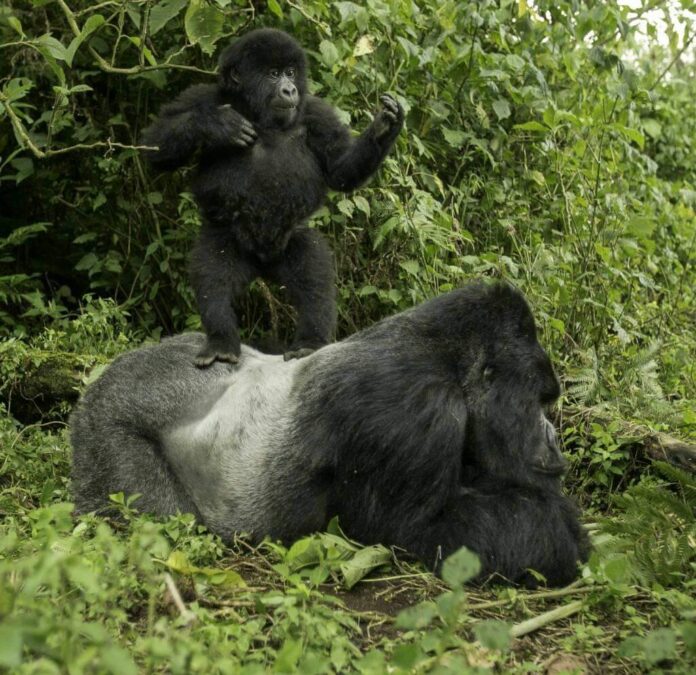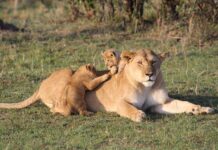A gorilla trek is a highlight of all visits done in Uganda, Rwanda and Congo and certainly mountain gorillas are the major reason as to why very many people visit these 3 destinations. Gorilla trekking can be conducted all year around in Uganda, Rwanda and Congo.
The best time to go gorilla trekking tours is during the months of June, July, August, September and December. This is because there is less rain and the parks are drier, making it simple to hike and see the gorillas.
Uganda is known as a whole round travel destination to any tourist planning to travel. This is due to its climate and location to the equator. The other factor making Uganda a travel destination throughout the year is Lake Victoria and its unique weather patterns to the climate.
Uganda mainly has two rainy seasons; the short season starts from October to November and the long rainy season starts from Mid-march to the end of May.
A gorilla trekking permit in Uganda costs $ 700 and 75% of the money raised is to conserve the gorilla surviving population. The government pockets 15% while 10% is meant for the local communities around the parks. As you purchase the permit, note that the cost includes park entrance fees, gorilla watching for an hour, advance trackers and ranger fees.
You can see gorillas in Uganda, Rwanda and Congo. However, note that gorillas are mainly divided into the mountain and the lowland with a couple of other sub-species in that. We suggest Rwanda, Uganda for views of the mountain gorillas and the Republic of Congo for the lowland gorillas. It is also possible to find mountain gorillas within the Democratic Republic of Congo however due to the instabilities within the country, it has been challenging in some areas.
Many tourists choose to travel from May to September to February since in these months, the amount of rain has reduced and it’s sunny in most of the destinations. December is one of the busiest months of the year in most national parks and it’s advisable to book the accommodation in time to avoid disappointments. During the Christmas season, most Uganda safaris tourists plan to take vacations to national parks so it’s always a peak season in the month of December.
Visiting in low season is okay to many tourists since accommodation is cheap to encourage many tourists to travel even though it’s a rainy season. Visiting in this season also means that you will enjoy the jungle with relatively low crowds. It’s also said that February and September are good months for a safari vacation in Uganda since there are less tourists visiting and the lodges are not fully booked as such in the high season.
The rainy season in Uganda affects people’s travels but that doesn’t mean that they don’t completely travel since this season is combined of both rains and sun shine. This means that the sun comes out as soon as it has just rained and most safari activities are able to be carried out without any disturbance. Mountain gorilla trekking as well as chimpanzee trekking goes on even during the rainy season and the national parks are fully in operation.
During the low season of March to May and October to November, most of the lodges reduce their rates to attract more tourists to book with them and this is an added advantage since even the gorilla permits are reduced to attract more tourists to Uganda.
Although tracking mountain gorillas can be conducted all year round in these two countries due to the somewhat damp seasons experienced by the national parks in which these gorillas stay, the majority of tourists prefer visiting from June to September as well as from December up to February.
Certainly, the rains although not very heavy make it challenging to trek the sheer landscape. During that time the rain falls for just one to two hours in about 3 days of the week and fro the rest the sun is out. However even in the dry months of Uganda, there are some little showers experienced in Bwindi.
The seasonality of the trackers can as well be accredited to the overall weather back in the home countries. During summers for instance in Europe, the number of gorilla safari trekkers is high and then in winter it greatly lowers. Also, there are some trekkers who take advantage of the seasonal discounts offered on the gorilla tracking permits.
A number of accommodation facilities in the areas where the gorillas are found as well will offer discounts in these months.
Within Rwanda, the initial rains are experienced at the end of February, March, April as well as May, and for that reason most of the tourists don’t visit during that time since it is muddy and pretty wet while tracking the mountain gorillas.
During these very months, since it is raining, there is a lot of food for the gorillas on the lower slopes and also the temperatures are lower on the lower slopes. Because of that, the gorillas stay on the lower slopes since food is easily accessible and it is warmer.
Therefore, if you choose to track in these months, you won’t have a very long trek and actually most trackers find the gorillas just after two hours of trekking meaning by 2:00pm they are back at their lodge.
A gorilla permit in Congo costs $400, in Uganda $600 while Rwanda charges $1500. The gorilla habituation experience in Uganda costs $1500 (permit alone). This special experience can only be offered in Uganda’s Bwindi Impenetrable Forest Park and allows visitors four hours with the primates. This is different from standard gorilla trekking safari where visitors only get one hour with the primates.
It is important to note that mountain gorillas can be tracked at any time of the year because their movements are not affected by changing seasons.
The perfect time to track gorillas is just after the rainy season has ended and the countryside is still looking green and fertile. Getting this time right is not easy considering that global warming has affected weather patterns a lot in African making it difficult to predict the beginning and end of the wet and dry seasons.



